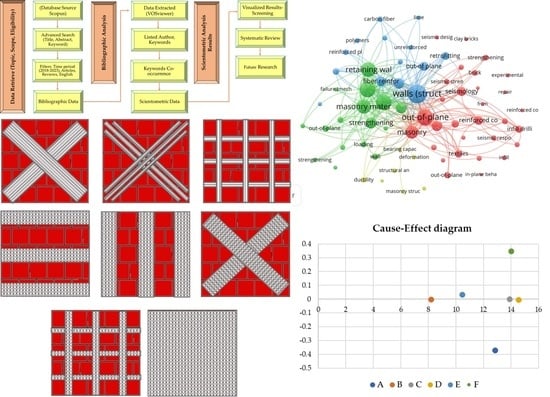Review of Out-of-Plane Strengthening Techniques of Unreinforced Masonry Walls
Abstract
:1. Introduction
1.1. Classification of the Strengthening Techniques of Masonry Walls
1.2. Objective of the Study
1.3. Research Significance
2. Scientometric Analysis of the Literature Overview
3. Classification of Masonry Walls Based on the Construction Materials
3.1. Concrete Block Masonry Walls
3.2. Stone Masonry Walls
3.3. Clay Brick Masonry Walls
4. Mechanical Properties of Strengthened URM Walls
5. Parameters Influencing the Effectiveness URM Strengthening
5.1. Masonry Walls Geometry
5.2. Masonry Rendering Mortars
5.3. Bond between Materials Interfaces
5.4. Loading and Boundary Conditions
6. Dematel Analysis
- -
- The importance degree of each factor is depicted horizontally indicating both the factor’s impact on the whole system and other system factors’ impact on the factor. In terms of the degree of importance, D is ranked in the first place, and F, C, A, E, and B, are ranked in the next places.
- -
- The degree of a factor’s influence on the system is depicted on the vertical vector. In general, the positive values represent a causal variable, and the negative values an effect. In this study, E and F are considered causal variables, and A, B, C, and D are regarded as an effect.
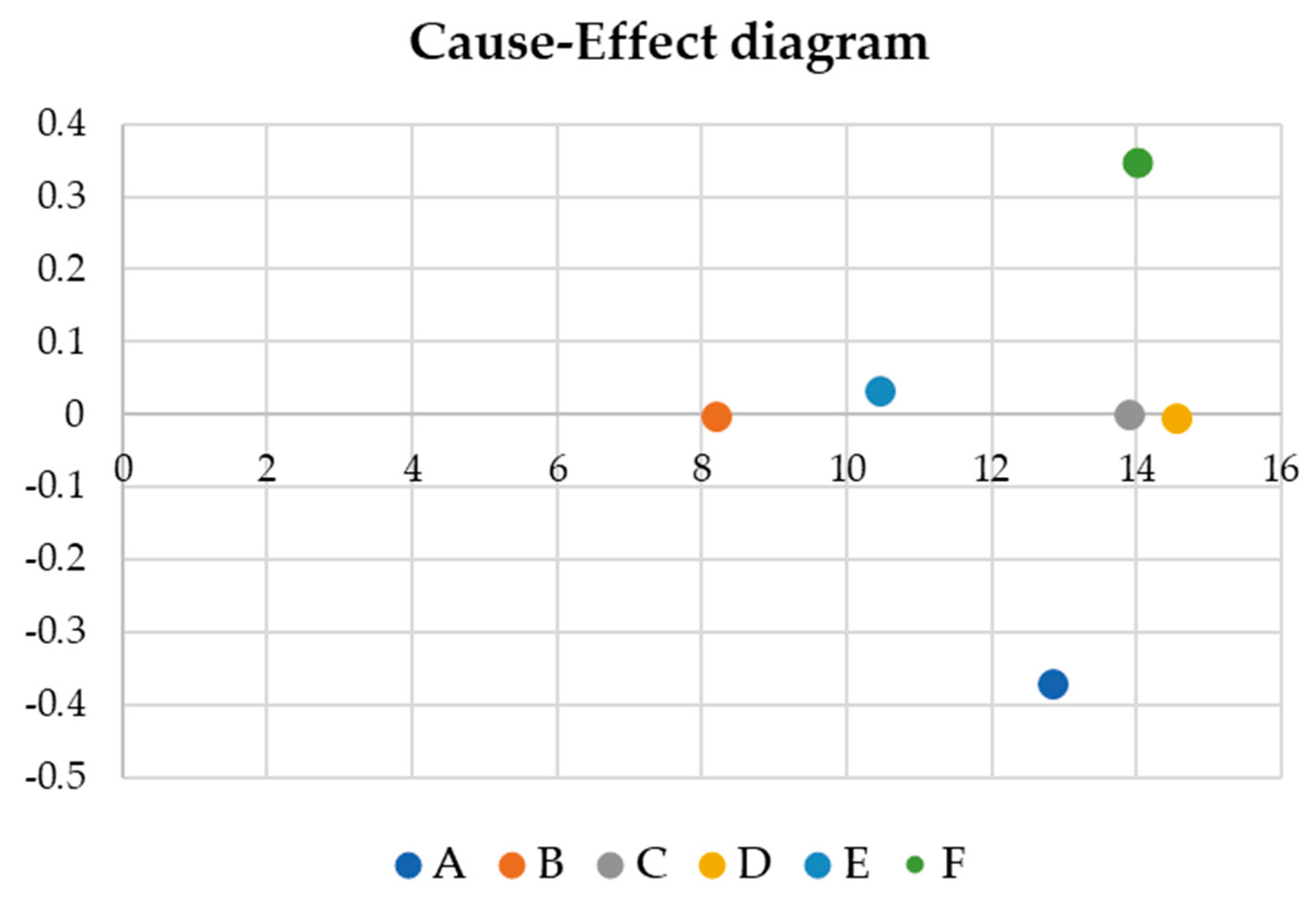
6.1. Previous Studies
6.2. Recommendations for the Future Studies
- It has been documented in the literature that there are various methods for strengthening masonry walls in the short term, but their long-term durability and efficiency are still uncertain. It is suggested that future studies should be conducted to evaluate the long-term performance of different strengthening methods under varying environmental conditions when subjected to transverse loading. This will provide a better understanding of the most effective and reliable methods for long-term use.
- It would be beneficial for future research to investigate new and economical methods for fortifying current masonry walls with ease. This would provide more practical and budget-friendly options for increasing the resilience of masonry constructions.
- Understanding the implications of heterogeneity and variability in masonry properties is crucial. Masonry walls can exhibit various levels of strength, durability, and stiffness due to differences in the materials utilized. Therefore, it is vital to investigate how these variations may impact the efficacy of different strengthening techniques and identify strategies to mitigate their impact.
- The optimization of strengthening techniques: Future studies can focus on recognizing the most effective strengthening techniques for precise categories of masonry walls and developing guidelines for their application.
- The development of a hybrid model for masonry walls: A hybrid model that combines experimental testing and numerical analysis has also been proposed. The hybrid model also involves two or more strengthening techniques which involve numerical, analytical, and experimental simulations.
- The present study has proven the importance of the factors that affect the effectiveness of each reinforcement. It is suggested to take into account all the important parameters that affect their appropriate choice. For this purpose, experimental and analytical research that would focus on the investigation of these factors would help in this critical issue. In addition, and equally important, it is important to clarify the factors that contribute to this multifactorial issue, adding in more detail other subcategories of factors.
7. Summary and Discussion
Author Contributions
Funding
Data Availability Statement
Acknowledgments
Conflicts of Interest
Nomenclature
| OoP | out-of-plane |
| FRP | fiber-reinforced polymers |
| SPB | steel plate bonding |
| FRM | fiber-reinforced mortar |
| TRM | textiles-reinforced mortars |
| PBO | polypara-phenylene-benzo-bisthiazole |
| CFRP | carbon fiber-reinforced polymer |
| SRG | steel-reinforced grout |
| FRCM | fabric-reinforced cementitious mortar |
| CRM | composite-reinforced mortar |
| URM | unreinforced mortar |
| FRPU | fiber-reinforced polyurethanes |
| BFRP | basalt fiber-reinforced polymer |
| GFRP | glass fiber-reinforced polymer |
| ECC | engineered cementitious composites |
| Dematel | Decision-making trial and evaluation laboratory |
References
- Zhang, M.; Ding, K.; Pang, L.; Ding, J. In-plane/out-of-plane seismic performance of masonry infilled RC frame structure made of nano-SiO2 reinforced mortar: Experimental study. J. Build. Eng. 2023, 68, 106104. [Google Scholar] [CrossRef]
- D’Ambra, C.; Lignola, G.P.; Prota, A.; Fabbrocino, F.; Sacco, E. FRCM strengthening of clay brick walls for out-of-plane loads. Compos. B Eng. 2019, 174, 107050. [Google Scholar] [CrossRef]
- Thomoglou, A.K.; Karabini, M.A.; Achillopoulou, D.V.; Rousakis, T.C.; Chalioris, C.E. Failure Mode Prediction of Unreinforced Masonry (URM) Walls Retrofitted with Cementitious Textile Reinforced Mortar (TRM). Fibers 2023, 11, 53. [Google Scholar] [CrossRef]
- Thomoglou, A.K.; Karabinis, A.I. Experimental investigation of the shear strength of hollow brick unreinforced masonry walls retrofitted with TRM system. Earthq. Struct. 2022, 22, 355–372. [Google Scholar]
- Thomoglou, A.Κ.; Karabinis, A.I. Experimental Investigation of Shear Strength of Solid Brick URM Walls retrofitted with TRM Jacket. In Proceedings of the 8th ECCOMAS Thematic Conference on Computational Methods in Structural Dynamics and Earthquake Engineering (COMPDYN 2021), Athens, Greece, 27–30 June 2021. [Google Scholar]
- Belliazzi, S.; Ramaglia, G.; Lignola, G.P.; Prota, A. Out-of-plane retrofit of masonry with Fiber-Reinforced Polymer and Fiber-Reinforced Cementitious Matrix systems: Normalized interaction diagrams and effects on mechanisms activation. J. Compos. Constr. 2021, 25, 04020081. [Google Scholar] [CrossRef]
- Hamoush, S.A.; McGinley, M.W.; Mlakar, P.; Scott, D.; Murray, K. Out of plane strengthening of masonry walls with reinforced composites. J. Compos. Constr. 2021, 5, 139–145. [Google Scholar] [CrossRef]
- Scacco, J.; Ghiassi, B.; Milani, G.; Lourenço, P.B. A fast modeling approach for numerical analysis of unreinforced and FRCM reinforced masonry walls under out-of-plane loading. Compos. B Eng. 2020, 180, 107553. [Google Scholar] [CrossRef]
- Bui, T.T.; Limam, A. Out of plane behaviour of hollow concrete block masonry walls unstrengthen and strengthen with CFRP composites. Compos. Part B 2014, 67, 527–542. [Google Scholar] [CrossRef]
- Fagone, M.; Ranocchiai, G. Experimental investigation on out-of-plane behavior of masonry panels strengthened with CFRP sheets. Compos. Part B Eng. 2018, 150, 14–26. [Google Scholar] [CrossRef]
- Jagdesh, P.; de-Prado-Gil, J.; Silva-Monteiro, N.; Martinez-Garcia, R. Assessing the compressive strength of self-compacting concrete with recycled aggregates from mix ratio using machine learning approach. J. Mater. Res. Technol. 2023, 24, 1483–1498. [Google Scholar] [CrossRef]
- Jagadesh, P.; Ramachandramurthy, A.; Murugesan, R. Processing of sugar cane bagasse ash and properties of processed sugar cane bagasse ash blended cements. Sadhana 2022, 47, 187. [Google Scholar] [CrossRef]
- Corradi, M.; Mustafaraj, E.; Speranzini, E. Sustainability considerations in remediation, retrofit, and seismic upgrading of historic masonry structures. Environ. Sci. Pollut. Res. 2023, 30, 25274–25286. [Google Scholar] [CrossRef]
- Isleem, H.F.; Jagadesh, P.; Ahmad, J.; Qaidi, S.; Althoey, F.; Najm, H.M.; Sabri, M.M.S. Finite element and analytical modelling of PVC-confined concrete columns under axial compression. Front. Mater. 2022, 10, 3389. [Google Scholar] [CrossRef]
- Saeed, A.; Najm, H.M.; Hassan, A.; Sabri, M.M.S.; Qaidi, S.; Mashaan, N.S.; Ansari, K. Properties and Applications of Geopolymer Composites: A Review Study of Mechanical and Microstructural Properties. Materials 2022, 15, 8250. [Google Scholar] [CrossRef] [PubMed]
- Qaidi, S.; Najm, H.M.; Abed, S.M.; Özkılıç, Y.O.; Al Dughaishi, H.; Alosta, M.; Sabri, M.M.S.; Alkhatib, F.; Milad, A. Concrete Containing Waste Glass as an Environmentally Friendly Aggregate: A Review on Fresh and Mechanical Characteristics. Materials 2022, 15, 6222. [Google Scholar] [CrossRef]
- Arslan, O.; Messali, F.; Smyrou, E.; Bal, I.E.; Rots, J.G. Mechanical modelling of the axial behaviour of traditional masonry walls metal tie connections in cavity walls. Constr. Build. Mater. 2021, 310, 12520. [Google Scholar] [CrossRef]
- Wang, Y.; Zhang, Y.; Wang, S.; Zhang, Z. Strengthening of masonry walls using inorganic coatings and carbon fiber-reinforced polymer sheets. Constr. Build. Mater. 2021, 272, 121831. [Google Scholar]
- Magenes, G.; Pauluzzi, C. Analytical and numerical investigation of masonry walls under out-of-plane loads. Eng. Struct. 2019, 196, 109273. [Google Scholar]
- Lourenço, P.B.; Barros, J.A.O.; Silva, L.S. Experimental behavior of grouted masonry walls under out-of-plane loading. Eng. Struct. 2016, 121, 262–276. [Google Scholar]
- Yang, L.; Li, Y.; Liu, Z.; Wu, Y. Experimental study on the out-of-plane behavior of coated masonry walls. Eng. Struct. 2020, 220, 110932. [Google Scholar]
- Rebeiz, K.S.; Kandil, U.F.; Saouma, V.E. Investigation of masonry wall out-of-plane behavior under dynamic loading with various coating materials using numerical simulations. Constr. Build. Mater. 2020, 232, 117239. [Google Scholar]
- Poggi, C.; Brigante, M.; Lagomarsino, S. Out-of-plane cyclic behavior of coated masonry walls. Eng. Struct. 2017, 136, 165–175. [Google Scholar]
- Kariou, F.A.; Triantafyllou, S.P.; Bournas, D.A.; Koutas, L.N. Out-of-plane response of masonry walls strengthened using textile-mortar system. Constr. Build. Mater. 2018, 165, 769–781. [Google Scholar] [CrossRef]
- D’Ambrisi, A.; Di Ludovico, M.; Nigro, E.; Uva, G. Experimental investigation on masonry walls strengthened by steel plates. Eng. Struct. 2013, 56, 706–719. [Google Scholar]
- Liu, Y.; Shen, J.; Wang, J. Experimental and numerical study on steel mesh reinforced masonry walls subjected to out-of-plane loads. J. Earthq. Eng. 2016, 20, 46–63. [Google Scholar]
- Bonelli, P.; Pampanin, S.; Palermo, A. Experimental investigation of steel-reinforced masonry walls under cyclic compression loading. Eng. Struct. 2019, 179, 371–384. [Google Scholar]
- Lourenço, P.B.; Franchin, P.; Rots, J.G. Steel plate connections for out-of-plane strengthening of clay brick masonry walls. Eng. Struct. 2018, 168, 439–451. [Google Scholar]
- ElGawady, M.A.; Khalifa, A.S.; Alsayed, S.H. Strengthening of stone masonry walls subjected to out-of-plane loading using FRP and steel reinforcements. Constr. Build. Mater. 2018, 174, 432–443. [Google Scholar]
- Latifi, R.; Hadzima-Nyarko, M.; Radu, D.; Rouhi, R. A Brief Overview on Crack Patterns, Repair and Strengthening of Historical Masonry Structures. Materials 2023, 16, 1882. [Google Scholar] [CrossRef]
- Di Ludovico, M.; Montanini, R.; Santandrea, M. Strengthening of Historical Masonry Walls with Prefabricated FRP Composites: Experimental and Numerical Investigation. Constr. Build. Mater. 2013, 224, 275–288. [Google Scholar]
- Binda, L.; Saisi, A.; Tiraboschi, C.; Zanzi, L. Lime-Based Mortars for the Strengthening of Historic Masonry Structures. Constr. Build. Mater. 2019, 217, 252–261. [Google Scholar]
- Esposito, R.; Rasulo, A.; Ricci, P. The Use of FRP to Strengthen Masonry Structures: Two Case Studies. Procedia Struct. Integr. 2018, 13, 1662–1670. [Google Scholar]
- Bati, S.; Borri, A.; Corradi, M.; Grazini, A. Seismic Strengthening of Historical Masonry Walls with Composite Materials: An Experimental Study. Constr. Build. Mater. 2016, 126, 210–222. [Google Scholar]
- Ferretti, Ε. Recent Advances in the Straps/Strips Technique for Out-of-plane Strengthening of Load-bearing Masonry Walls. Procedia Struct. Integr. 2020, 25, 33–46. [Google Scholar] [CrossRef]
- Viskovic, A.; Rinaldin, G.; Modena, C. Experimental assessment of combined FRP and grout injection strengthening of masonry walls under out-of-plane loads. Compos. Struct. 2017, 163, 251–265. [Google Scholar]
- Ming, S.; Dai, H.; Zhu, Y.; Zhang, Z.; Zhou, L. Experimental study of strengthening masonry walls using NSM FRP strips and grouting. Constr. Build. Mater. 2019, 206, 223–233. [Google Scholar]
- Wang, Y.; Sun, Q.; Jiang, C. Experimental study on the out-of-plane behavior of reinforced and coated masonry walls. Eng. Struct. 2019, 186, 408–417. [Google Scholar]
- El-Salakawy, E.; El-Said, M.; El-Fakharany, M. Epoxy Resin and FRP Composites for the Strengthening of Masonry Walls under Seismic Loads. Eng. Struct. 2019, 180, 84–98. [Google Scholar]
- Albutainy, M.; Galal, K. Experimental investigation of reinforced concrete masonry shear walls with C shaped masonry units boundary elements. Structures 2021, 34, 3667–3683. [Google Scholar] [CrossRef]
- Shi, C.; Zhang, J.; Liang, H.; Xu, H.; Liu, F.; Zhao, Y. Study on the Impact Resistance of FRP Pasted onto a Blastproof Partition Wall under Out-of-Plane Repeated Impact Load. Coatings 2022, 12, 1836. [Google Scholar] [CrossRef]
- Al-Jaberi, Z.; Myers, J.J.; ElGawady, M.A. Experimental and Analytical Approach for Prediction of Out-of-Plane Capacity of Reinforced Masonry Walls Strengthened with Externally Bonded FRP Laminate. J. Compos. Constr. 2019, 23, 04019026. [Google Scholar] [CrossRef]
- Chen, Z.; Wang, X.; Yu, Q. Strengthening of out-of-plane masonry walls using carbon fiber-reinforced polymer vertical strips. Compos. Struct. 2019, 217, 25–34. [Google Scholar]
- Corbi, I. FRP reinforcement of masonry panels by means of C-fiber strips. Compos. B Eng. 2013, 47, 348–356. [Google Scholar] [CrossRef]
- Papanicolaou, C.G.; Triantafillou, T.C.; Papathanasiou, M.; Karlos, K. Textile reinforced mortar (TRM) versus FRP as strengthening material of URM walls: Out-of-plane cyclic loading. Mater. Struct. 2008, 41, 143–157. [Google Scholar] [CrossRef]
- Donnini, J.; Maracchini, G.; Lenci, S.; Corinaldesi, V.; Quagliarini, E. TRM reinforced tuff and fired clay brick masonry: Experimental and analytical investigation on their in-plane and out-of-plane behavior. Constr. Build. Mater. 2021, 272, 121643. [Google Scholar] [CrossRef]
- Colombo, M.; Valente, T.; Barros, J.A.O.; Aprile, A.; Lourenço, L. Fibre reinforced mortar application for out-of-plane strengthening of schist walls. Constr. Build. Mater. 2016, 121, 185–197. [Google Scholar] [CrossRef]
- Maddaloni, G.; Di Ludovico, M.; Balsamo, A.; Prota, A. Out-of-plane experimental behaviour of T-shaped full scale masonry wall strengthened with composite connections. Compos. B Eng. 2016, 93, 328–343. [Google Scholar] [CrossRef]
- Kumar, S.; Rai, D.C. Enhancing Flexural Strength of Unreinforced Masonry Members Using Cementitious Matrix-Based Composites. In Stability and Failure of High Performance Composite Structures. Composites Science and Technology; Singh, S.B., Barai, S.V., Eds.; Springer: Singapore, 2022. [Google Scholar]
- Cucuzza, R.; Domaneschi, M.; Camata, G.; Carlo, G.; Formisano, A.; Brigante, D. FRCM retrofitting techniques for masonry walls: A literature review and some laboratory tests. Procedia Struct. Integr. 2023, 44, 2190–2197. [Google Scholar] [CrossRef]
- Kouris, L.A.S.; Triantafillou, T.C. State-of-the-art on strengthening of masonry structures with textile reinforced mortar (TRM). Constr. Build. Mater. 2018, 188, 1221–1233. [Google Scholar] [CrossRef]
- Marques, R.; Lourenço, P.B. Structural behaviour and design rules of confined masonry walls: Review and proposals. Constr. Build. Mater. 2019, 217, 137–155. [Google Scholar] [CrossRef]
- Pradhan, B.; Zizzo, M.; Sarhosis, V.; Cavaleri, L. Out-of-plane behaviour of unreinforced masonry infill walls: Review of the experimental studies and analysis of the influencing parameters. Structures 2021, 33, 4387–4406. [Google Scholar] [CrossRef]
- Padalu, P.K.V.R.; Singh, Y.; Das, S. Out-of-plane flexural strengthening of URM wallettes using basalt fibre reinforced polymer composite. Constr. Build. Mater. 2019, 216, 272–295. [Google Scholar] [CrossRef]
- Ferretti, E.; Pascale, G. Some of the Latest Active Strengthening Techniques for Masonry Buildings: A Critical Analysis. Materials 2019, 12, 1151. [Google Scholar] [CrossRef]
- Rousakis, T.; Ilki, A.; Kwiecien, A.; Viskovic, A.; Gams, M.; Triller, P.; Ghiassi, B.; Benedetti, A.; Rakicevic, Z.; Colla, C.; et al. Deformable Polyurethane Joints and Fibre Grids for Resilient Seismic Performance of Reinforced Concrete Frames with Orthoblock Brick Infills. Polymers 2020, 12, 2869. [Google Scholar] [CrossRef] [PubMed]
- Thomoglou, A.K.; Falara, M.G.; Gkountakou, F.I.; Elenas, A.; Chalioris, C.E. Smart Cementitious Sensors with Nano-, Micro-, and Hybrid-Modified Reinforcement: Mechanical and Electrical Properties. Sensors 2023, 23, 2405. [Google Scholar] [CrossRef]
- Thomoglou, A.K.; Falara, M.G.; Voutetaki, M.E.; Fantidis, J.G.; Tayeh, B.A.; Chalioris, C.E. Electromechanical properties of multi-reinforced self-sensing cement-based mortar with MWCNTs, CFs, and PPs. Constr. Build. Mater. 2023, 400, 132566. [Google Scholar] [CrossRef]
- Jagadesh, P.; Nagarajan, V.; Karthik Prabhu, T.; Arunachalam K, K. Effect of nano-titanium dioxide on mechanical properties of fly ash and ground granular blast furnace slag based geopolymer concrete. J. Build. Eng. 2022, 61, 105235. [Google Scholar]
- Thomoglou, A.K.; Fantidis, J.G.; Voutetaki, M.E.; Metaxa, Z.S.; Chalioris, C.E. Mechanical Characterization of Nano-Reinforced Mortar: X-ray Micro-CT for 3D Imaging of Microstructure. Eng. Proc. 2023, 41, 4. [Google Scholar]
- Joyklad, P.; Ali, N.; Verre, S.; Magbool, H.M.; Elnemr, A.; Qureshi, M.I.; Hussain, Q.; Chaiyasarn, K. Experimental Study on the Out-of-Plane Behavior of Brick Masonry Walls Strengthened with Mortar and Wire Mesh: A Pioneer Study. Infrastructures 2021, 6, 165. [Google Scholar] [CrossRef]
- Coccia, S.; Carlo, F.D.; Imperatore, S. Masonry walls retrofitted with vertical FRP rebars. Buildings 2020, 10, 72. [Google Scholar] [CrossRef]
- Calderon, S.; Sandoval, F.J.; Araya-Letelier, C.; Inzunza, G.; Milani, G. Quasi-static testing of concrete masonry shear walls with different horizontal reinforcement schemes. J. Build. Eng. 2021, 38, 102201. [Google Scholar] [CrossRef]
- Guo, Z.; Tang, L.; Zong, Z.; Xiong, Y.; Jiang, T.; Xu, H. Cyclic Out-of-Plane Testing of Clay Brick Masonry Walls Strengthened with Glass Fiber-Reinforced Polymer Strips. ACI Struct. J. 2023, 120, 10. [Google Scholar]
- Türkmen, Ö.S.; De Vries, B.T.; Wijte, S.N.; Ingham, J.M. Out-of-plane behaviour of clay brick masonry walls retrofitted with flexible deep mounted CFRP strips and additional single-sided FRCM overlay. Structures 2021, 33, 2459–2474. [Google Scholar] [CrossRef]
- Deng, M.; Dong, Z.; Dai, J.; Zhao, X. Out-of-plane strengthening of URM walls using different fiber-reinforced materials. Constr. Build Mater. 2023, 362, 129597. [Google Scholar] [CrossRef]
- Nekoonam, A.; Nasab, R.F.; Jafari, S.; Nikolaidis, T.; Ale Ebrahim, N.; Fashandi, S.A.M. A scientometric methodology based on co-word analysis in gas turbine maintenance. Tech. Gaz. 2023, 30, 361–372. [Google Scholar]
- Owolabi, T.A.; Sajjad, M. A global outlook on multi-hazard risk analysis: A systematic and scientometric review. Int. J. Disaster Risk Reduct. 2023, 92, 103727. [Google Scholar] [CrossRef]
- Kałuża, M. Experimental Analysis of Surface Application of Fiber-Reinforced Polymer Composite on Shear Behavior of Masonry Walls Made of Autoclaved Concrete Blocks. Buildings 2022, 12, 2208. [Google Scholar] [CrossRef]
- Gattesco, N.; Ingrid, B. Out-of-plane behavior of reinforced masonry walls: Experimental and numerical study. Compos. B Eng. 2017, 128, 39–52. [Google Scholar] [CrossRef]
- Maccarini, H.; Vasconcelos, G.; Rodrigues, H.; Ortega, J.; Lourenço, P.B. Out-of-plane behavior of stone masonry walls: Experimental and numerical analysis. Constr. Build. Mater. 2018, 179, 430–452. [Google Scholar] [CrossRef]
- Al-Saidy, A.H.; Al-Busaidi, M.; El-Gamal, S.; Abu Sohel, K.M. Flexural Strengthening of Stone Masonry Walls Using Textile-Reinforced Sarooj Mortar. Materials 2023, 16, 5703. [Google Scholar] [CrossRef]
- Thomoglou, A.; Rousakis, T.; Karabinis, A. Numerical modeling of shear behavior of URM strengthened with FRCM or FRP subjected to seismic loading. In Proceedings of the 16th European Conference on Earthquake Engineering, Thessaloniki, Greece, 18–20 June 2018; pp. 18–21. [Google Scholar]
- Thomoglou, A.K.; Rousakis, T.C.; Achillopoulou, D.V.; Karabinis, A.I. Ultimate shear strength prediction model for unreinforced masonry retrofitted externally with textile reinforced mortar. Earthq. Struct. 2020, 19, 4411–4425. [Google Scholar]
- D’Ambra, C.; Lignola, G.P.; Prota, A.; Sacco, E.; Fabbrocino, F. Experimental performance of FRCM retrofit on out-of-plane behaviour of clay brick walls. Compos. Part B Eng. 2018, 148, 198–206. [Google Scholar] [CrossRef]
- Tarek, D.; Ahmed, M.M.; Hussein, H.S.; Zeyad, A.M.; Al-Enizi, A.M.; Yousef, A.; Ragab, A. Building envelope optimization using geopolymer bricks to improve the energy efficiency of residential buildings in hot arid regions. Case Stud. Constr. Mater. 2022, 17, e01657. [Google Scholar] [CrossRef]
- Bellini, A.; Shahreza, S.K.; Mazzotti, C. Cyclic bond behavior of FRCM composites applied on masonry substrate. Compos. Part B Eng. 2019, 169, 189–199. [Google Scholar] [CrossRef]
- Wang, C.; Forth, J.P.; Nikitas, N.; Sarhosis, V. Retroftting of masonry walls by using a mortar joint technique; experiments and numerical validation. Eng. Struct. 2016, 11, 58–70. [Google Scholar] [CrossRef]
- Wang, C.; Sarhosis, V.; Nikitas, N. Strengthening/retroftting techniques on unreinforced masonry structure/element subjected to seismic loads: A literature review. Open Constr. Build. Technol. J. 2018, 12, 251–268. [Google Scholar] [CrossRef]
- Spiridon, I.A.; Ungureanu, D.; Țăranu, N.; Onuțu, C.; Isopescu, D.N.; Șerbănoiu, A.A. Structural Assessment and Strengthening of a Historic Masonry Orthodox Church. Buildings 2023, 13, 835. [Google Scholar] [CrossRef]
- Askouni, P.D.; Papanicolaou, C.G. Experimental investigation of bond between glass textile reinforced mortar overlays and masonry: The effect of bond length. Mater. Struct. 2017, 50, 164. [Google Scholar] [CrossRef]
- Verre, S. Numerical Strategy for Column Strengthened with FRCM/SRG System. Buildings 2022, 12, 2187. [Google Scholar] [CrossRef]
- Wang, J.; Wan, C.; Shen, L.; Zeng, Q.; Ji, X. Compressive behavior of masonry columns confined with basalt textile-reinforced concrete. J. Build. Eng. 2023, 75, 107019. [Google Scholar] [CrossRef]
- Maddaloni, G.; Di Ludovico, M.; Balsamo, A.; Maddaloni, G.; Prota, A. Dynamic assessment of innovative retrofit techniques for masonry buildings. Compos. Part B Eng. 2018, 147, 147–161. [Google Scholar] [CrossRef]
- ojdys, Ł.; Krajewski, P. Tensile Behaviour of FRCM Composites for Strengthening of Masonry Structures—An Experimental Investigation. Materials 2021, 14, 3626. [Google Scholar] [CrossRef]
- Grande, E.; Milani, G. Numerical simulation of the tensile behavior of FRCM strengthening systems. Compos. Part B Eng. 2020, 189, 107886. [Google Scholar] [CrossRef]
- Yardim, Y.; Lalaj, O. Shear strengthening of unreinforced masonry wall with different fiber reinforced mortar jacketing. Constr. Build. Mater. 2016, 102, 149–154. [Google Scholar] [CrossRef]
- Mandor, A.; El Refai, A. Assessment and modeling of the debonding failure of fabric-reinforced cementitious matrix (FRCM) systems. Compos. Struct. 2021, 275, 114394. [Google Scholar] [CrossRef]
- Colombi, P.; D’Antino, T. Analytical assessment of the stress-transfer mechanism in FRCM composites. Compos. Struct. 2019, 220, 961–970. [Google Scholar] [CrossRef]
- Bellini, A.; Incerti, A.; Bovo, M.; Mazzotti, C. Effectiveness of FRCM Reinforcement Applied to Masonry Walls Subject to Axial Force and Out-Of-Plane Loads Evaluated by Experimental and Numerical Studies. Int. J. Arch. Herit. 2017, 12, 376–394. [Google Scholar] [CrossRef]
- De Santis, S.; De Canio, G.; de Felice, G.; Meriggi, P.; Roselli, I. Out-of-plane seismic retrofitting of masonry walls with Textile Reinforced Mortar composites. Bull. Earthq. Eng. 2019, 17, 6265–6300. [Google Scholar] [CrossRef]
- D’Antino, T.; Carozzi, F.G.; Colombi, P.; Poggi, C. Out-of-plane maximum resisting bending moment of masonry walls strengthened with FRCM composites. Compos. Struct. 2018, 202, 881–896. [Google Scholar] [CrossRef]
- Adegoke, A.; Oladokun, T.; Ayodele, T.; Agbato, S.E.; Jinadu, A. DEMATEL method of analysing the factors influencing the decision to adopt virtual reality technology by real estate firms in Lagos property market. Smart Sustain. Built Environ. 2021, 11, 891–917. [Google Scholar] [CrossRef]
- Ortega Heras, J.; Vasconcelos, G.; Rodrigues, H.; Correia, M. Assessment of the influence of horizontal diaphragms on the seismic performance of vernacular buildings. Bull. Earthq. Eng. 2018, 16, 3871–3904. [Google Scholar] [CrossRef]
- Gatta, G.; Pane, V.; Lignola, G.P.; Prota, A. Experimental investigation on grouted historic masonry walls subjected to out-of-plane loads. Eng. Struct. 2019, 194, 263–275. [Google Scholar]
- Furtado, A.; Rodrigues, H.; Arêde, A.; Melo, J.; Varum, H. The use of textile-reinforced mortar as a strengthening technique for the infill walls out-of-plane behaviour. Comp. Struct. 2021, 255, 113029. [Google Scholar] [CrossRef]
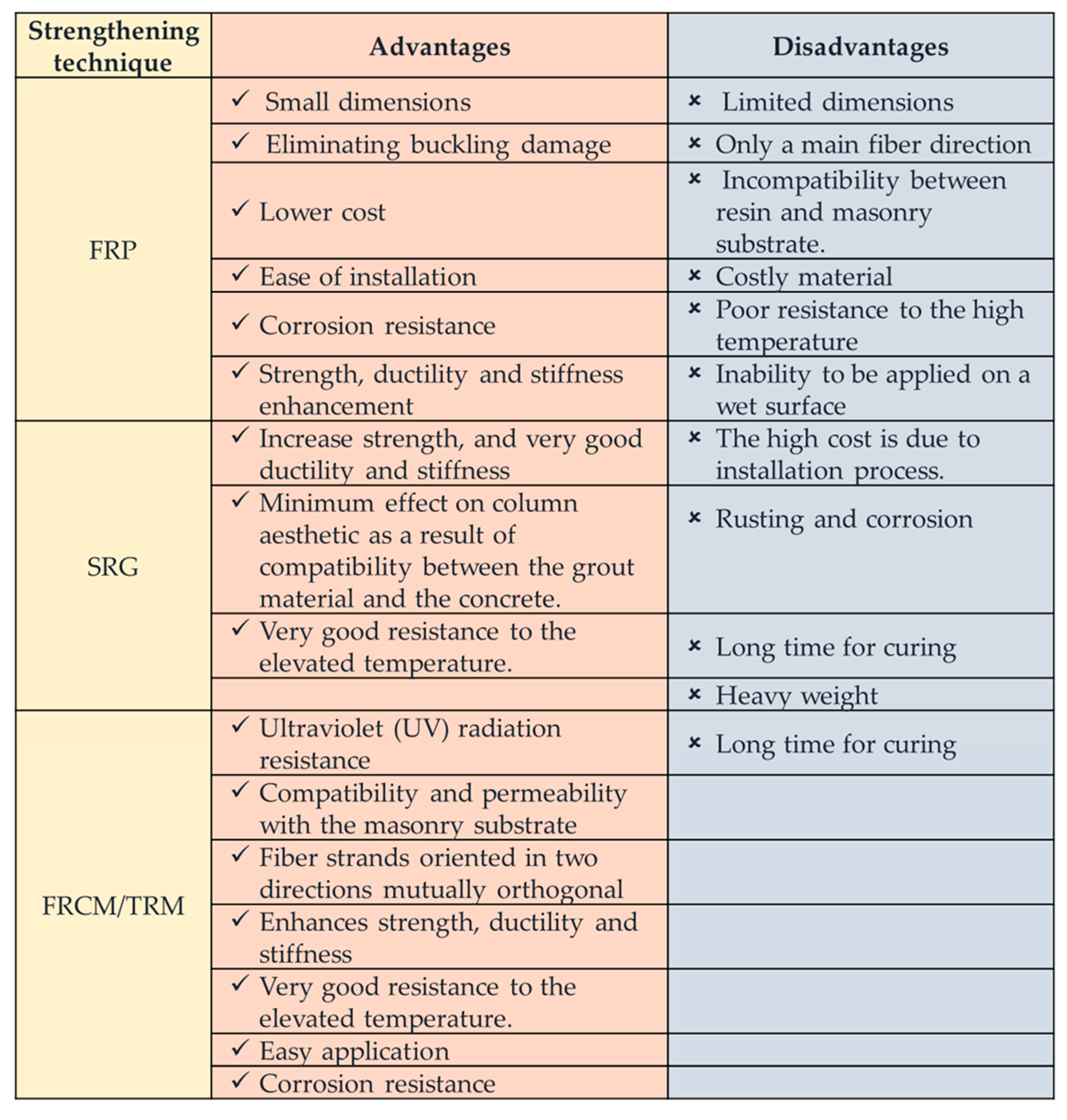

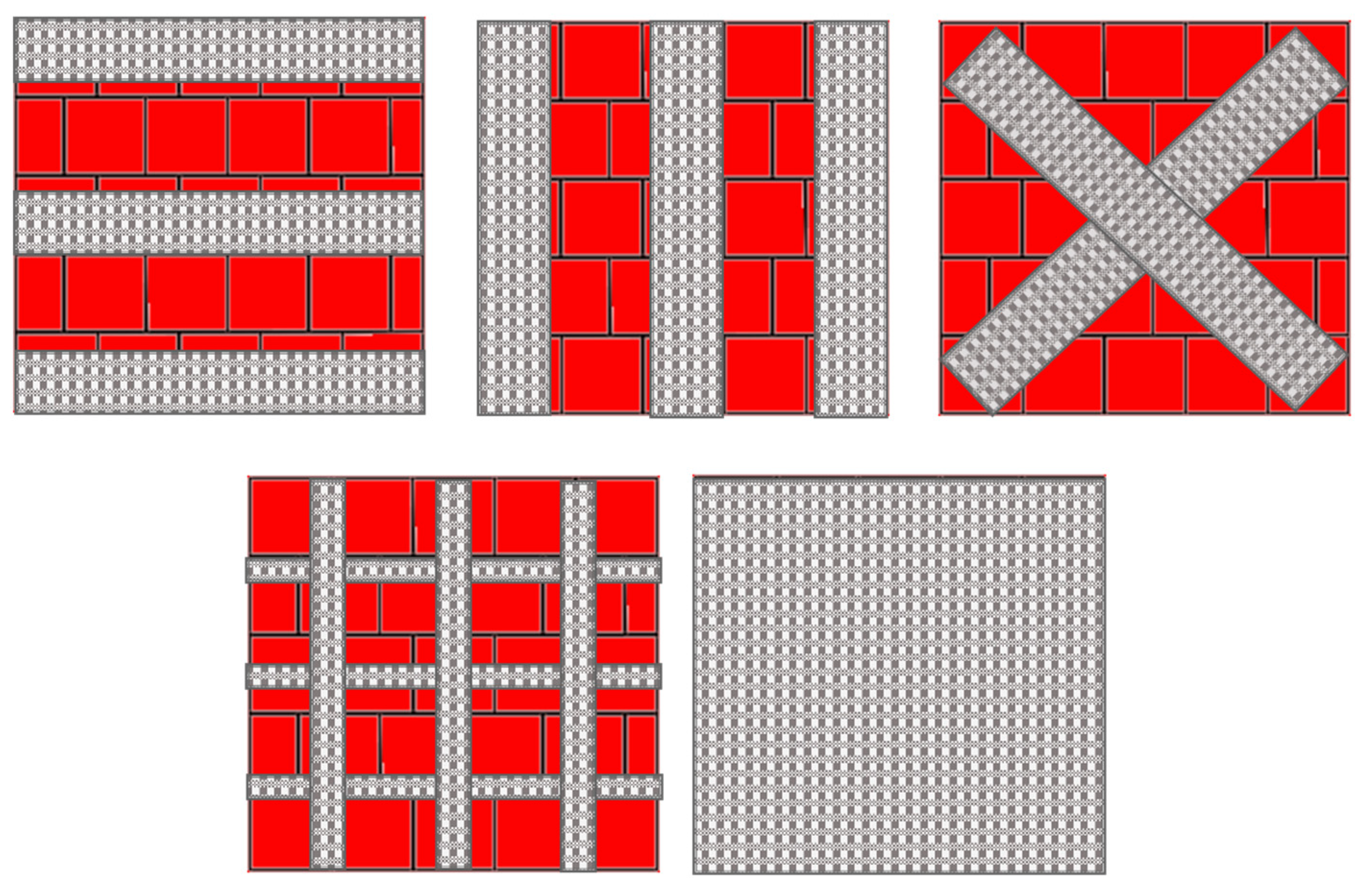
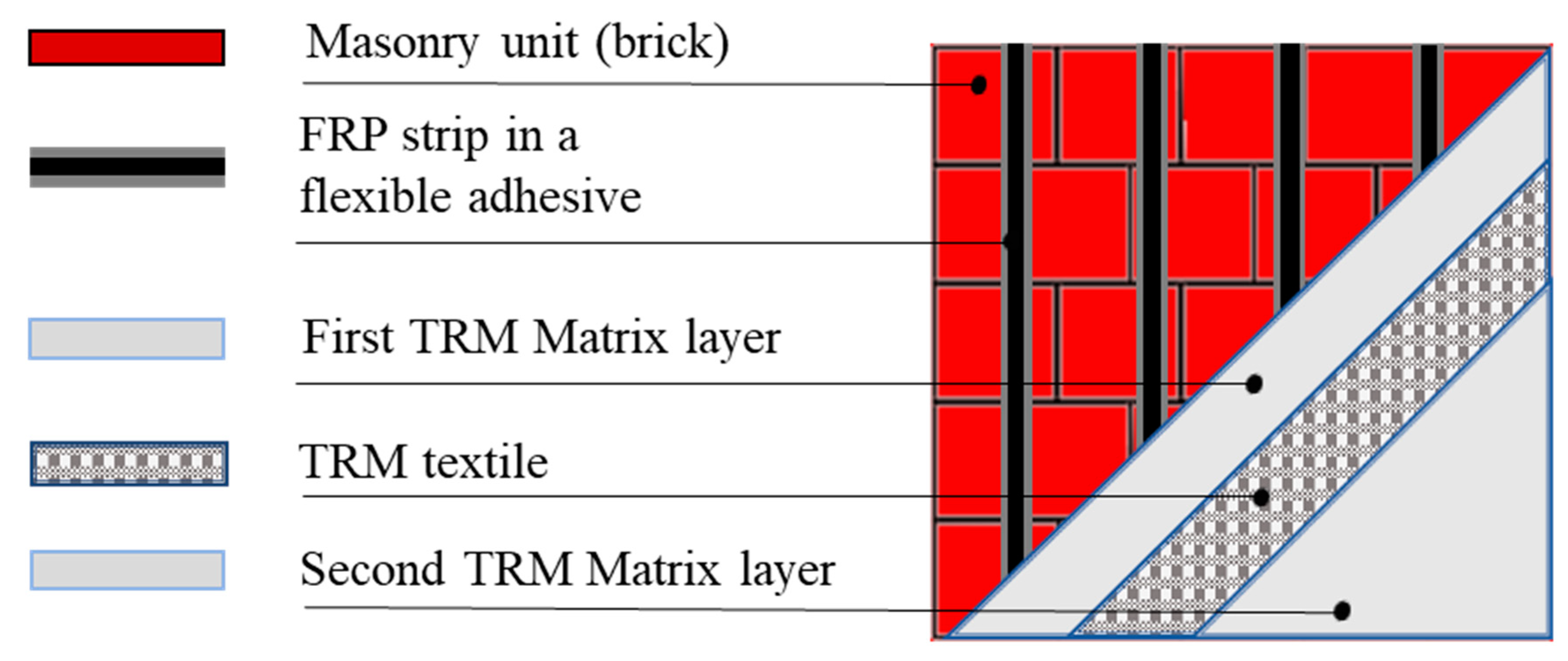
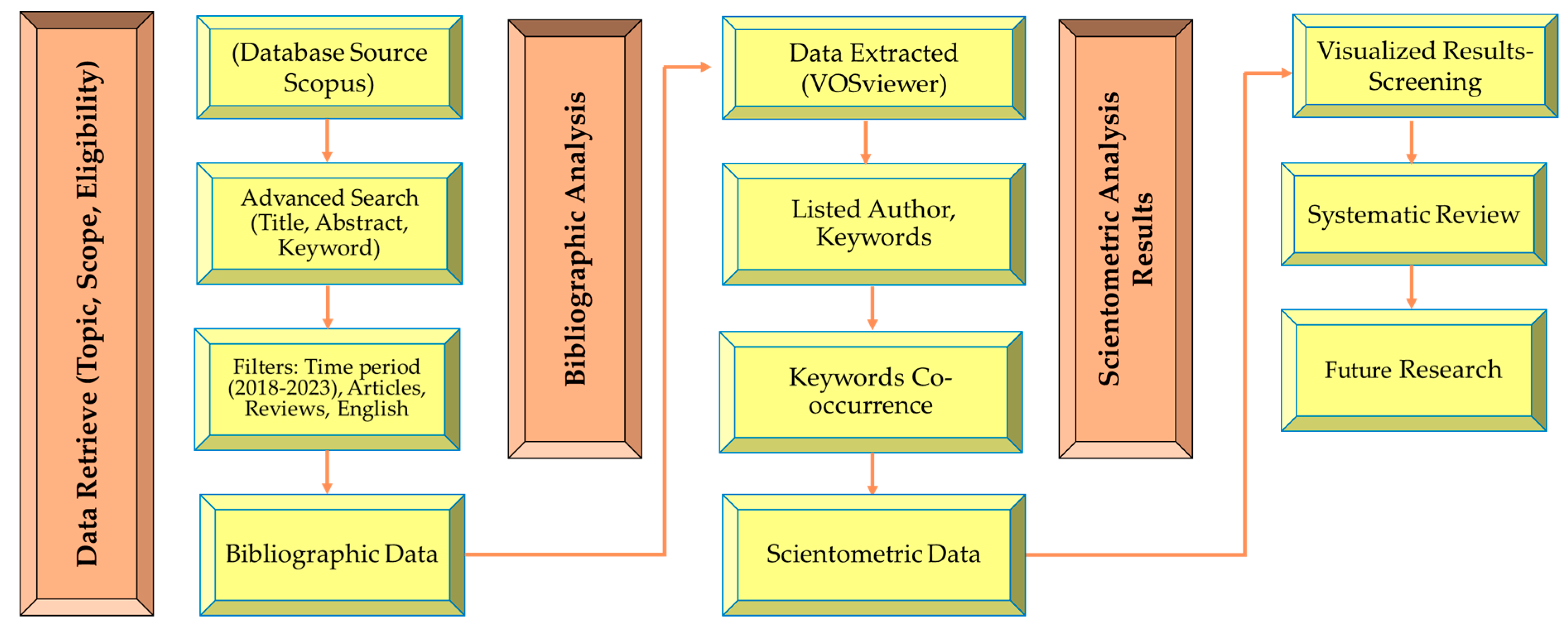


| Authors | Masonry Wall Type | Strengthening Techniques | Strengthening Layouts |
|---|---|---|---|
| [9] | Hollow concrete block | CFRP | Horizontal and vertical (grid) |
| [10] | Solid brick | CFRP | Anchored CFRP sheets |
| [42] | Concrete blocks | GFRP, CFRP | Vertical layers |
| [54] | Solid clay brick | BFRP | Vertical, diagonal, and grid reinforcement |
| [61] | Cement-clay interlocking bricks | SRG | Vertical steel bars, wire mesh |
| [65] | Clay brick | GFRP + FRCM | Vertical GFRP strips and single-sided grid overlay |
| [70] | Solid brick, rubble stones, cobblestones | GTRM | External glass grid |
| [72] | Stone | BTRM | External basalt grid |
| [75] | Solid clay brick | BTRM | External basalt grid |
Disclaimer/Publisher’s Note: The statements, opinions and data contained in all publications are solely those of the individual author(s) and contributor(s) and not of MDPI and/or the editor(s). MDPI and/or the editor(s) disclaim responsibility for any injury to people or property resulting from any ideas, methods, instructions or products referred to in the content. |
© 2023 by the authors. Licensee MDPI, Basel, Switzerland. This article is an open access article distributed under the terms and conditions of the Creative Commons Attribution (CC BY) license (https://creativecommons.org/licenses/by/4.0/).
Share and Cite
Thomoglou, A.K.; Jagadesh, P.; Voutetaki, M.E. Review of Out-of-Plane Strengthening Techniques of Unreinforced Masonry Walls. Fibers 2023, 11, 78. https://doi.org/10.3390/fib11090078
Thomoglou AK, Jagadesh P, Voutetaki ME. Review of Out-of-Plane Strengthening Techniques of Unreinforced Masonry Walls. Fibers. 2023; 11(9):78. https://doi.org/10.3390/fib11090078
Chicago/Turabian StyleThomoglou, Athanasia K., P. Jagadesh, and Maristella E. Voutetaki. 2023. "Review of Out-of-Plane Strengthening Techniques of Unreinforced Masonry Walls" Fibers 11, no. 9: 78. https://doi.org/10.3390/fib11090078
APA StyleThomoglou, A. K., Jagadesh, P., & Voutetaki, M. E. (2023). Review of Out-of-Plane Strengthening Techniques of Unreinforced Masonry Walls. Fibers, 11(9), 78. https://doi.org/10.3390/fib11090078








